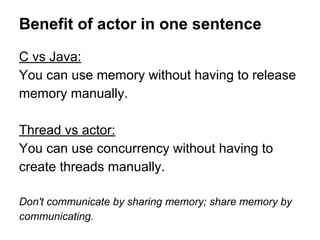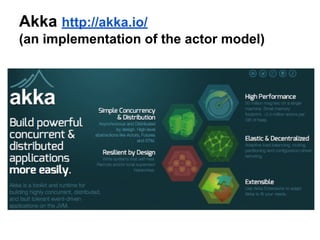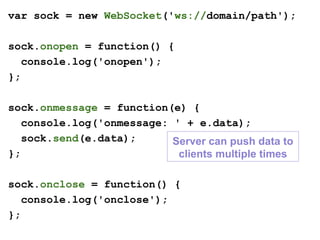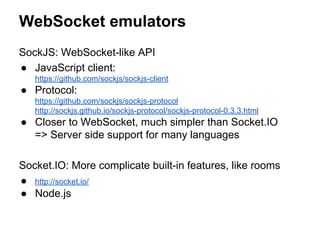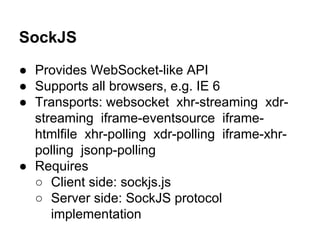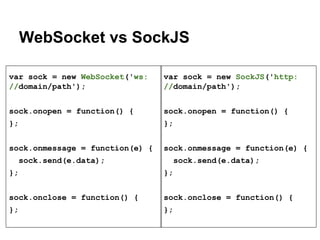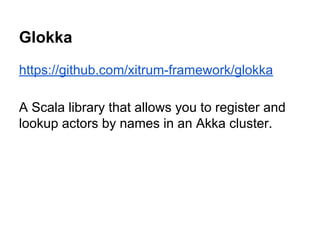Develop realtime web with Scala and Xitrum
- 1. Develop realtime and distributed web with Scala and Xitrum Ngoc Dao Saigon Xmas 2014 Hanoi New Year 2015
- 3. Slides will be shared at: http://www.slideshare.net/ngocdaothanh This talk is long. Please ask question immediately when you have one. For questions/discussions after this talk, please post to: https://www.facebook.com/groups/720666194693928 You can also post to scala-user group: https://groups.google.com/d/forum/scala-user
- 4. About me Working at Mobilus in Tokyo: http://mobilus.co.jp/ ● Server side ● Android, iOS Interests: ● Realtime and distributed systems ● Web frameworks (have been written several for Erlang, Scala, Java) ● Big data, analytics (learning Apache Spark) Open source: ● https://github.com/ngocdaothanh ● https://github.com/xitrum-framework ● https://github.com/sinetja ● https://github.com/netty
- 5. Scala@Japan ● Meetups: ~monthly (in Tokyo) ● Conferences: yearly ○ 2013: http://scalamatsuri.org/2013/en/program/index.html ○ 2014: http://scalamatsuri.org/en/program/index.html http://scalamatsuri.org/en/unconference/index.html
- 6. Red Sand Dunes Phan Thiet
- 7. About you I guess you already know OOP. Functional programming: ● How many of you have used Ruby? (somewhat functional, popular) ● Have used a more functional language? (Lisp, Haskell, Erlang, Clojure, F# etc.) Scala looks like Java and runs on JVM. It’s convenient if you already know Java: ● How many of you have used Java? ● Have used Scala?
- 8. ● Why use Scala? Compare with Java, Ruby, Node.js etc. ● Books, sites Getting started: ● Install Scala ● Ways to run Scala program: Hello World Scala = OOP + functional: ● Learn Scala’s functional feature via collections ● Learn Scala’s OOP feature via the Animals exercise Some tools: ● Development: ○ REPL (Read–Eval–Print Loop), SBT (Scala Build Tool) ○ IDEs: Eclipse, IntelliJ ● Production: ○ xitrum-package ○ Scalive PART 1/5: Scala overview
- 9. ● Web app ≈ normal app + routing ● Xitrum: ○ Compare with Scalatra, Lift, Play ○ Basic usage: ■ Add routes to the previous demos ■ respondXxx ○ Swagger UI, Swagger Codegen ○ Metrics ○ i18n PART 2/5: Use Scala for web
- 10. ● Compare with Node.js ● Future and future composition ● Actor model and Akka actor ↑ NEW programming paradigm A language that doesn't change the way you think about programming is not worth learning. ○ Actor vs Thread ○ Actor vs Future ○ Some pitfalls ● Akka FSM PART 3/5: Use Scala for concurrency
- 11. ● Realtime web ● WebSocket, Socket.IO, SockJS ● Tictactoe web game PART 4/5: Use Scala for realtime web
- 12. PART 5/5: Use Scala for distributed systems Compare with Redis Remoting: ● Akka remoting Clustering: ● Akka clustering ● Glokka ● Hazelcast Scale Tictactoe to multiple servers
- 14. ● Why use Scala? Compare with Java, Ruby, Node.js etc. ● Books, sites Getting started: ● Install Scala ● Ways to run Scala program: Hello World Scala = OOP + functional: ● Learn Scala’s functional feature via collections ● Learn Scala’s OOP feature via the Animals exercise Some tools: ● Development: ○ REPL (Read–Eval–Print Loop), SBT (Scala Build Tool) ○ IDEs: Eclipse, IntelliJ ● Production: ○ xitrum-package ○ Scalive PART 1/5: Scala overview
- 15. ● Trendy: Used by by Apple, Foursquare, Guardian, LinkedIn, Netflix, Quora, Sony Pictures Entertainment, Twitter, UK Guardian etc. ● Compare with Java, Ruby, Node.js etc. ● Language: ≈ Java + Ruby ○ Fast speed of Java + nice syntax of Ruby: Faster than Ruby + syntax nicer than Java ○ Flexible: ■ Static + dynamic: Compiled to Java .class or run as script like Ruby ■ OOP of Java + functional of Ruby http://www.quora.com/Why-is-Swift-so-similar-to-Scala ● Not only a good language: Scala has toys ○ Ecosystem: Can reuse all Java libs ○ Concurrent/parallel: Future, Akka (≈ Erlang) ○ Big data: Apache Spark Why use Scala?
- 16. Books, sites ● http://www.scala-lang.org/documentation/ ● http://twitter.github.io/effectivescala/ ● https://github.com/lauris/awesome-scala ● https://github.com/akullpp/awesome-java ● Search
- 17. Learn Scala “enough” to do projects How much is “enough”?
- 18. Level A1: Beginning application programmer ● Java-like statements and expressions: standard operators, method calls, conditionals, loops, try/catch ● class, object, def, val, var, import, package ● Infix notation for method calls ● Simple closures ● Collections with map, filter, etc ● for-expressions http://www.scala-lang.org/old/node/8610
- 19. Level A2: Intermediate application programmer ● Pattern matching ● Trait composition ● Recursion, in particular tail recursion ● XML literals
- 20. Level A3: Expert application programmer ● Folds, i.e. methods such as foldLeft, foldRight ● Streams and other lazy data structures ● Actors ● Combinator parsers
- 21. Level L1: Junior library designer ● Type parameters ● Traits ● Lazy vals ● Control abstraction, currying ● By-name parameters
- 22. Level L2: Senior library designer ● Variance annotations ● Existential types (e.g., to interface with Java wildcards) ● Self type annotations and the cake pattern for dependency injection ● Structural types (aka static duck typing) ● Defining map/flatmap/withFilter for new kinds of for-expressions ● Extractors
- 23. Level L3: Expert library designer ● Early initializers ● Abstract types ● Implicit definitions ● Higher-kinded types A1 → A2/L1 → A3/L2 → L3
- 25. Install Scala 1. Download from http://www.scala-lang.org/ 2. Config PATH: PATH=path/to/scala-2.11.4/bin:$PATH REPL (Read–Eval–Print Loop) demo: scala command
- 26. Ways to run Scala program ● println("Hello World") ● Run as script with scala ● Compile with scalac and run with scala ● Compile with scalac and run with java
- 28. SBT (Scala Build Tool) http://www.scala-sbt.org/ ● Dependency library manager + build tool ● Like “gem” + “rake” of Ruby ● Like Maven, Gradle ● Has plugins to generate project files for IDEs, like Eclipse and IntelliJ ● Has plugins to collect and package .jar files, ready to deploy to production environment (Make, Ant are just build tools, not dependency library managers)
- 29. Install SBT 1. Download from http://www.scala-sbt.org/download.html 2. Config PATH: PATH=path/to/sbt/bin/dir:$PATH sbt: java -Xms256M -Xmx512M -jar `dirname $0`/sbt-launch-0.13.7.jar "$@" Learn SBT: http://www.scala-sbt.org/documentation.html
- 30. Simple SBT-based project structure
- 31. build.sbt organization := "com.mycompany" name := "hello" version := "1.0" scalaVersion := "2.11.4" scalacOptions ++= Seq("-deprecation", "-feature", "-unchecked") javacOptions ++= Seq("-source", "1.6", "-target", "1.6") libraryDependencies += "tv.cntt" %% "xitrum" % "3.21" libraryDependencies += "ch.qos.logback" % "logback-classic" % "1.1.2" Packaged .jar file: hello_2.11-1.0.jar
- 32. $ sbt tasks console Starts the Scala interpreter compile Compiles sources clean Deletes files produced by the build run Runs a main class package Produces project jar file publish Publishes project jar file to a repository publish-local Copies project jar file to ~/.ivy2 test Executes all tests test-only Executes the tests provided as arguments test-quick Executes the tests that either failed before
- 33. SBT plugins http://www.scala-sbt.org/release/docs/Community-Plugins.html Generate Eclipse project: https://github.com/typesafehub/sbteclipse Generate IntelliJ project: https://github.com/mpeltonen/sbt-idea Package project: https://github.com/xitrum-framework/xitrum-package
- 34. Hello World demo ● sbt console ● sbt run ● sbt eclipse ● Run in Eclipse ● Debug in Eclipse ● sbt xitrum-package ● Run with java ● Add dependency library http://search.maven.org/ ● Scalive
- 35. Rules of thumb Use dependency manager: ● Do not download dependency libraries manually ● Do not commit dependency libraries IDEs: ● Generate project files for IDEs ● Do not commit project files
- 37. Scala = OOP + functional Unifying Object-Oriented and Functional Programming http://web.stanford.edu/class/cs94si/OOPFP.pdf
- 38. Functional language ● Pass a function as an argument to another function => Convenient syntax f(123, g) f(123, { // ... }) ● Immutable data structures => Thread-safe ○ Tail recursion
- 39. Learn Scala’s functional feature via collections ● From a collection, create another collection of same size => map ● From a collection, create another collection of larger size => flatMap ● From a collection, create another collection of smaller size => filter ● From a collection, create one element => foldLeft, foldRight, reduce http://www.scala-lang.org/api/current/index.html#scala.collection.Seq
- 40. map
- 41. flatMap
- 42. filter
- 43. foldLeft Roll
- 44. val a = 1 var b = 1 b = 2 val → immutable: val c = Seq(1, 2, 3) var → immutable: var d = Seq(1, 2, 3) d = Seq(4, 5, 6) val → mutable: val e = Array(1, 2, 3) e(0) = 4 var → mutable: var f = Array(1, 2, 3) f = Array(4, 5, 6) f(0) = 4
- 45. val VS var immutable VS mutable collection Order of preference (best practice): ● val ● var ● val → immutable: strictly functional ● var → immutable ● val → mutable ● var → mutable: do not use Some languages only allow val → immutable Scala is flexible: var and mutable are OK to use in small, closed scope
- 46. For your curiosity: How to write programs with only constants? Example problem: Without var, mutable: ● Generate a collection of positive numbers that are <= n, and are multiple of 3 or 5. gen(n: Int): Seq[Int] ● Calculate sum of all numbers in a collection. sum(nums: Seq[Int]): Int
- 47. With var and mutable import scala.collection.mutable.ArrayBuffer def gen(n: Int): Seq[Int] = { val buf = ArrayBuffer[Int]() var i = 1 while (i <= n) { if (i % 3 == 0 || i % 5 == 0) buf.append(i) i += 1 } buf }
- 48. def gen(n: Int): Seq[Int] = { val nums = 1 to n nums.filter { i => i % 3 == 0 || i % 5 == 0 } } def gen(n: Int): Seq[Int] = { for { i <- 1 to n if (i % 3 == 0 || i % 5 == 0) } yield i }
- 49. Without var and mutable ● Use recursion to loop ● Optimize: Use tail recursion ○ Use accumulator
- 50. def gen(n: Int): Seq[Int] = { // Stop condition if (n < 3) return Seq() // Recursion if (n % 3 == 0 || n % 5 == 0) gen(n - 1) :+ n else gen(n - 1) } Stackoverflow if n is big enough
- 51. def genAcc( n: Int, acc: Seq[Int] ): Seq[Int] = { if (n < 3) return acc // Tail recursion; Scala compiler will // convert to “while” loop if (n % 3 == 0 || n % 5 == 0) genAcc(n - 1, n +: acc) else genAcc(n - 1, acc) } def gen(n: Int) = genAcc(n, Seq())
- 52. def genAcc( n: Int, acc: Seq[Int] ): Seq[Int] = { if (n < 3) return acc if (n % 3 == 0 || n % 5 == 0) genAcc(n - 1, n +: acc) else genAcc(n - 1, acc) } How to write programs with only constants? State is stored at function arguments State is set/changed at function call
- 54. How I learn an OOP language: ● Learn basic syntax ● Learn collections ● Animals exercise: abstraction, encapsulation, inheritance, polymorphism Learn Scala’s OOP feature via the Animals exercise
- 55. Animals exercise trait (interface) Animal ● name: String ● talk() class Cat extends Animal class Dog extends Animal class Zoo ● addAnimal(a: Animal) ● talkAll()
- 56. scala-lang.org → /api/ Companion object Class Trait http://youtu.be/GQxUEAXX_fE How to read Scaladoc
- 58. ● Web app ≈ normal app + routing ● Xitrum: ○ Compare with Scalatra, Lift, Play ○ Basic usage: ■ Add routes to the previous demos ■ respondXxx ○ Swagger UI, Swagger Codegen ○ i18n PART 2/5: Use Scala for web
- 59. Web ≈ Routing function Input Output function Input Output
- 60. Web ≈ Routing A web library/framework is not worth using if its routing feature sucks. function Request Response function ResponseRequest Request Request Router
- 61. Xitrum http://xitrum-framework.github.io/ Compare with Scalatra, Lift, Play Demos: https://github.com/xitrum-framework/xitrum-demos Skeleton to create new project: https://github.com/xitrum-framework/xitrum-new
- 62. ● Basic usage: ○ Add routes to the previous demos ○ respondXxx ● Swagger UI, Swagger Codegen ● Metrics ● i18n Xitrum
- 64. ● Compare with Node.js ● Future and future composition ● Actor model and Akka actor ↑ NEW programming paradigm A language that doesn't change the way you think about programming is not worth learning. ○ Actor vs Thread ○ Actor vs Future ○ Some pitfalls ● Akka FSM PART 3/5: Use Scala for concurrency
- 65. Compare with Node.js Node.js: ● Single thread => Single core ● Complicate to scale to multiple cores or multiple servers; except for shared-nothing (non-realtime) systems ● Callback hell Scala: ● Multiple threads; immutable data structures, future, and actor provide more safety for multithread programming ● Easy to scale ● No callback hell
- 66. Future http://docs.scala-lang.org/overviews/core/futures.html Think about Future as a thread pool with some nice methods to: ● send tasks to it ● get results ● handle failures ● compose the above together
- 67. Future composition f f f f f f f f1 f2 f3 f Think about Node.js callback hell! ● Future.sequence ● for comprehension
- 68. val taskParams = Seq(123, 456, 789) val taskFutures: Seq[Future[String]] = tasks.map { ms => future { Thread.sleep(ms) s"Result for $ms" } } val gatheredFuture: Future[Seq[String]] = Future.sequence(taskFutures)
- 69. val purchase = for { usd <- future { con.getValue(USD) } chf <- future { con.getValue(CHF) } if isProfitable(usd, chf) } yield connection.buy(amount, chf) purchase onSuccess { amount => println("Purchased " + amount + " CHF") }
- 71. ↑ NEW programming paradigm A language that doesn't change the way you think about programming is not worth learning. Alan Perlis (the first recipient of the Turing Award) Actor model and Akka actor
- 72. Benefit of actor in one sentence C vs Java: You can use memory without having to release memory manually. Thread vs actor: You can use concurrency without having to create threads manually. Don't communicate by sharing memory; share memory by communicating.
- 73. Actor model ● Actor = states + mailbox + behaviors (msg handlers) ● From outside, can’t manipulate actors directly. ● To interact with an actor, must send messages to it. ● Each actor has a mailbox, messages are put to mailbox, and processed one by one. ← An actor is like a single threaded process (each actor is like a Node.js process); it doesn’t do more than one thing at a time. http://www.cs.tsukuba.ac.jp/~yas/cs/csys-2013/2013-12-03/
- 74. Actor vs Thread Thread: ● Heavy weight: Can only create not too many threads; usually: 2000~5000 ● Shared state ← Source of bugs ● Passive: Have to call object.method() to make the object alive. Actor: ● Light weight: Can create millions of actors; usually: ~2.5 million actors/GB ● Self contained, shared nothing ● Active: Actors are alive by themselves. ← Easy to model programs that have millions of on-going things (very high level of concurrency), like MMOG games.
- 75. Actor vs Thread ● Thread: n dimensions, hard to reason about. ● Actor: 1D, one thing at a time. var1 var1
- 76. Actor vs Thread Just like JVM automatically manages memory for you: ● Actor is a high level logical way to think, to model programs. ● At lower level, actors run above a thread pool.
- 77. Actor vs Future Actor: ● Messaging ● Scheduling ● FSM ● Monitoring and supervision ● Location transparency (actors on one server can send messages to actors on another server) => Easier to scale out to multiple servers/clustering Future: ● Syntax is easier to write ● Composable ● More typesafe
- 78. Akka http://akka.io/ (an implementation of the actor model) Summary: https://jraviton.wordpress.com/2015/01/16/lets-brush-up-on-scala-actors/
- 79. Demo: Counter // First, define messages object Counter { case class Inc(amount: Int) case class Dec(amount: Int) }
- 80. import akka.actor.Actor // Define actor state and message handlers class Counter(name: String) extends Actor { // Actor state private var value = 0 ...
- 81. ... import Counter._ // Message handlers def receive = { case Inc(amount) => value += amount println(s"Value: $value") case Dec(amount) => value -= amount println(s"Value: $value") } }
- 82. import akka.actor.{ActorSystem, Props} // Think of this as a thread pool val system = ActorSystem("mysystem") // Create actor reference (actor instance) val c1 = system.actorOf( Props(new Counter("mylock")) ) // Send messages to the actor c1 ! Counter.Inc(1) c1 ! Counter.Dec(2)
- 83. Some pitfalls Send mutable msgs between actors. ↑ May lead to bug, if actor A sends msg M to actor B, state of B incorporates M, then M is later changed by A. => Shared memory Fix: Use immutable messages.
- 84. Some pitfalls From inside actor: anObject.foo(new Callback { def onCallback() { // Modify actor state directly } }) ↑ May lead to bug, because the actor’s thread and the callback’s thread may be 2 different threads. Remember: An actor is like a single threaded process, can’t do more than one thing at a time. An actor should be self contained, shared nothing. Fix: self ! msgFromCallback
- 85. Good read ● Concurrent Programming for Scalable Web Architectures http://berb.github.io/diploma-thesis/index.html ● Functions + Messages + Concurrency = Erlang http://www.infoq.com/presentations/joe-armstrong- erlang-qcon08 ● Akka doc http://doc.akka.io/docs/akka/2.3.8/scala.html
- 87. Akka FSM ● FSM: Finite State Machine ● Implemented based on actors ● Very good for realtime multiplayer games, to manage states of game sessions and inter- player interactions Example: Code Lock https://github.com/ngocdaothanh/code-lock-fsm-akka
- 89. ● Realtime web ● WebSocket, Socket.IO, SockJS ● Tictactoe web game PART 4/5: Use Scala for realtime web
- 90. HTTP problem: Server can send data to clients only one time. Some years ago: Flash (open TCP socket connection to server) Now: WebSocket https://developer.mozilla.org/en- US/docs/WebSockets/Writing_WebSocket_clie nt_applications Realtime web ≈ server push
- 91. var sock = new WebSocket('ws://domain/path'); sock.onopen = function() { console.log('onopen'); }; sock.onmessage = function(e) { console.log('onmessage: ' + e.data); sock.send(e.data); }; sock.onclose = function() { console.log('onclose'); }; Server can push data to clients multiple times
- 92. WebSocket problem New browsers are required: ● Internet Explorer: 10 ● Firefox: 6 ● Chrome: 4 ● Safari: 5 ● Opera: 12.10
- 93. WebSocket emulators SockJS: WebSocket-like API ● JavaScript client: https://github.com/sockjs/sockjs-client ● Protocol: https://github.com/sockjs/sockjs-protocol http://sockjs.github.io/sockjs-protocol/sockjs-protocol-0.3.3.html ● Closer to WebSocket, much simpler than Socket.IO => Server side support for many languages Socket.IO: More complicate built-in features, like rooms ● http://socket.io/ ● Node.js
- 94. SockJS ● Provides WebSocket-like API ● Supports all browsers, e.g. IE 6 ● Transports: websocket xhr-streaming xdr- streaming iframe-eventsource iframe- htmlfile xhr-polling xdr-polling iframe-xhr- polling jsonp-polling ● Requires ○ Client side: sockjs.js ○ Server side: SockJS protocol implementation
- 95. var sock = new WebSocket('ws: //domain/path'); sock.onopen = function() { }; sock.onmessage = function(e) { sock.send(e.data); }; sock.onclose = function() { }; var sock = new SockJS('http: //domain/path'); sock.onopen = function() { }; sock.onmessage = function(e) { sock.send(e.data); }; sock.onclose = function() { }; WebSocket vs SockJS
- 97. Tictactoe web game Exercises: ● Instead of letting player actors send messages directly to each other, use an intermediate game actor for each game. ● Let users other than the players watch games. ● Use Scala.js to convert game logic code written in Scala to JavaScript, to share game logic code between server side and client side. http://www.scala-js.org/ ● Use Akka FSM instead of become.
- 99. Compare with Redis Remoting: ● Akka remoting Clustering: ● Akka clustering ● Glokka ● Hazelcast Scale Tictactoe to multiple servers PART 5/5: Use Scala for distributed systems
- 100. Compare with Redis Redis: ● Separate process ● Single point of failure Akka, Hazelcast: ● In-process => Faster, easier to use ● Redundancy, failover
- 103. Glokka https://github.com/xitrum-framework/glokka A Scala library that allows you to register and lookup actors by names in an Akka cluster.
- 104. Hazelcast Program ≈ Code + Data Distributed Program ≈ Distributed Code + Distributed Data Akka ≈ Distributed Code Hazelcast ≈ Distributed Data + Distributed Code http://hazelcast.org/ http://hazelcast.com/
- 105. http://docs.hazelcast.org/docs/3.4/manual/html/ ● Distributed data structures: Map, Multimap, Queue, Set, List, Topic (pub/sub), Lock, AtomicLong, AtomicReference, Semaphore, CountDownLatch, IdGenerator ● JCache ● Distributed ExecutorService ● Transaction ● MapReduce, Aggregators ● Integration: Hibernate, Servlet session replication, Spring ● Client: Java, C++, .NET, REST, memcache
- 106. Scale Tictactoe to multiple servers Only need to change Lobby lookup => Use Glokka Config Akka cluster: config/akka.conf

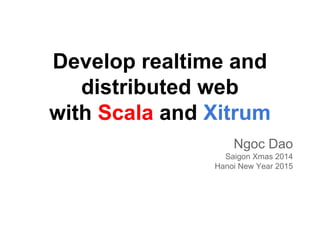





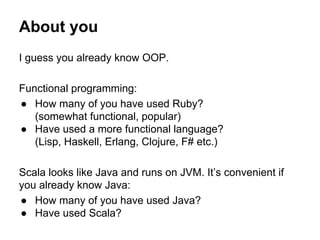

















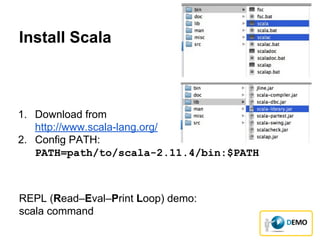


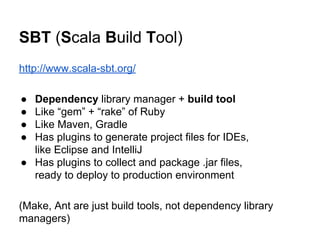

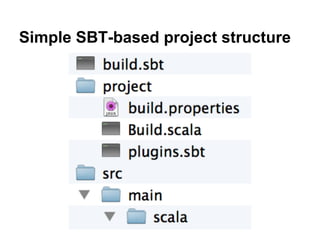


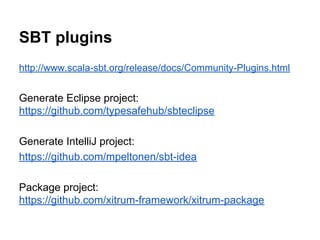
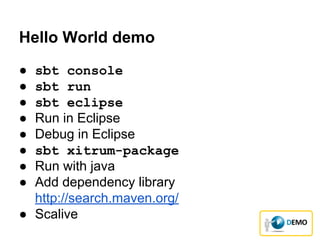


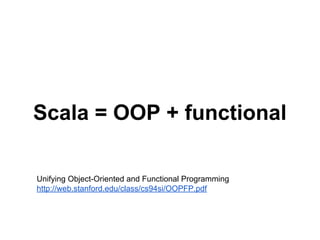






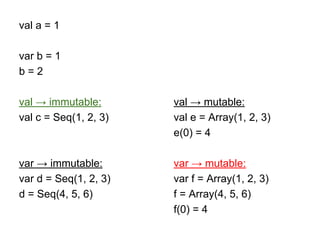
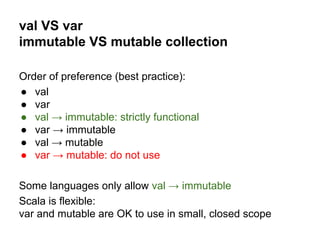
![For your curiosity: How to write
programs with only constants?
Example problem:
Without var, mutable:
● Generate a collection of positive numbers
that are <= n, and are multiple of 3 or 5.
gen(n: Int): Seq[Int]
● Calculate sum of all numbers in a collection.
sum(nums: Seq[Int]): Int](https://image.slidesharecdn.com/developrealtimewebwithscalaandxitrum-150108184131-conversion-gate02/85/Develop-realtime-web-with-Scala-and-Xitrum-46-320.jpg)
![With var and mutable
import scala.collection.mutable.ArrayBuffer
def gen(n: Int): Seq[Int] = {
val buf = ArrayBuffer[Int]()
var i = 1
while (i <= n) {
if (i % 3 == 0 || i % 5 == 0)
buf.append(i)
i += 1
}
buf
}](https://image.slidesharecdn.com/developrealtimewebwithscalaandxitrum-150108184131-conversion-gate02/85/Develop-realtime-web-with-Scala-and-Xitrum-47-320.jpg)
![def gen(n: Int): Seq[Int] = {
val nums = 1 to n
nums.filter { i =>
i % 3 == 0 || i % 5 == 0
}
}
def gen(n: Int): Seq[Int] = {
for {
i <- 1 to n
if (i % 3 == 0 || i % 5 == 0)
} yield i
}](https://image.slidesharecdn.com/developrealtimewebwithscalaandxitrum-150108184131-conversion-gate02/85/Develop-realtime-web-with-Scala-and-Xitrum-48-320.jpg)

![def gen(n: Int): Seq[Int] = {
// Stop condition
if (n < 3) return Seq()
// Recursion
if (n % 3 == 0 || n % 5 == 0)
gen(n - 1) :+ n
else
gen(n - 1)
}
Stackoverflow
if n is big enough](https://image.slidesharecdn.com/developrealtimewebwithscalaandxitrum-150108184131-conversion-gate02/85/Develop-realtime-web-with-Scala-and-Xitrum-50-320.jpg)
![def genAcc(
n: Int, acc: Seq[Int]
): Seq[Int] = {
if (n < 3) return acc
// Tail recursion; Scala compiler will
// convert to “while” loop
if (n % 3 == 0 || n % 5 == 0)
genAcc(n - 1, n +: acc)
else
genAcc(n - 1, acc)
}
def gen(n: Int) = genAcc(n, Seq())](https://image.slidesharecdn.com/developrealtimewebwithscalaandxitrum-150108184131-conversion-gate02/85/Develop-realtime-web-with-Scala-and-Xitrum-51-320.jpg)
![def genAcc(
n: Int, acc: Seq[Int]
): Seq[Int] = {
if (n < 3) return acc
if (n % 3 == 0 || n % 5 == 0)
genAcc(n - 1, n +: acc)
else
genAcc(n - 1, acc)
}
How to write programs with only
constants?
State is stored
at function arguments
State is set/changed
at function call](https://image.slidesharecdn.com/developrealtimewebwithscalaandxitrum-150108184131-conversion-gate02/85/Develop-realtime-web-with-Scala-and-Xitrum-52-320.jpg)



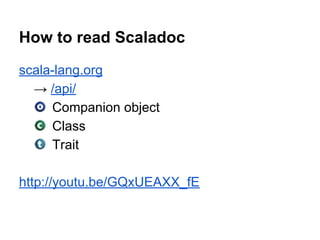



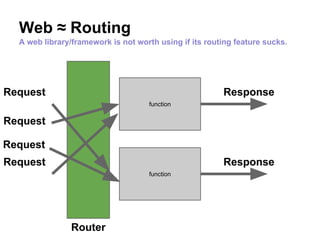







![val taskParams = Seq(123, 456, 789)
val taskFutures: Seq[Future[String]] =
tasks.map { ms =>
future {
Thread.sleep(ms)
s"Result for $ms"
}
}
val gatheredFuture: Future[Seq[String]] =
Future.sequence(taskFutures)](https://image.slidesharecdn.com/developrealtimewebwithscalaandxitrum-150108184131-conversion-gate02/85/Develop-realtime-web-with-Scala-and-Xitrum-68-320.jpg)



